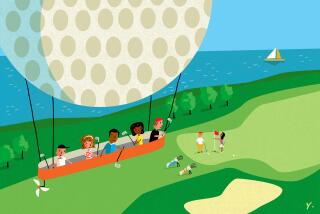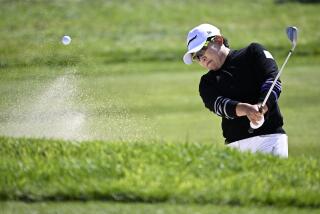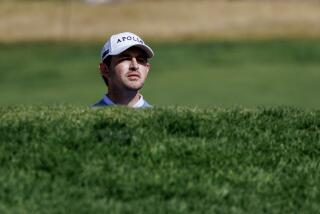Low Gear
Here are the numbers and the letters. This is the combination:
983K ... 983E ... R510 ... R580 ... ProV1x ... Si3.
Looks more like some kind of messed-up lottery ticket, doesnât it? Or logarithms in heat. Or what it says on the sides of the race cars at Le Mans.
As he stands there on the driving range at Pebble Beach, a bucket of golf balls dumped at his feet, Davis Love III doesnât realize it, but he has just taken up a new job. Love is a vacation planner. One by one, he is sending those little round balls on a flight at about the same speed as, but with a higher trajectory than, an airplane taking off, without the airplane.
Those balls are taking a trip, baby. The boarding pass is provided by Love, whose combination is 983E and ProV1x. The numbers and the letters translate into the kind of driver he uses and the kind of ball he plays, both made by Titleist, which is having quite a year so far.
Using that equipment, Love was 21 under par at the Bob Hope and 14 under par at Pebble Beach in his first two tournaments of the year. If that sounds pretty good, it is. Then again, it isnât, at least not when you compare it to what happened on the PGA Tour the weeks before, even though Loveâs score was good enough to win at Pebble.
Itâs an all-out race to the scoring table for the best professional golfers in the world, who are armed with the most technologically advanced equipment available and assaulting par and posting scores as if nothing can stop them short of wind, rain, making the holes smaller or filling the balls with custard.
But before everyone gets too carried away on the technology side, a little examination of the factors is in order.
It took one tournament to show that if there isnât any wind and the greens are soft, the scores are going to be borderline ridiculous.
This is what Rocco Mediate said at Kapalua, where he was 23 under and lost by eight shots to Ernie Els:
âItâs amazing. Weâre really, really good. Weâre the best at what we do in the whole world,â Mediate said. âThatâs the bottom line. [You] can put us on the hardest golf course in the history of the world with no wind, we will destroy it, period, as a tour. Weâll kill it. Thatâs what happened here.â
At Kapalua, in the first tournament of the year, Els shot 31 under par. No one had done that before in a four-round event. In fact, it beat the tournament record by five shots and was 13 shots better than defending champion Sergio Garciaâs winning score.
Els won again the next week at Honolulu at 16 under, six shots better than Jerry Kellyâs winning score the year before. At Phoenix, Vijay Singh continued the trend and won with a 63 on the last day and a total of 23 under, five shots better than Chris DiMarcoâs winning score in 2002.
The Bob Hope Classic was what it always is and thatâs room service for the pros. Jay Haas, Tim Herron and Pat Perez all shot 61s, and they didnât even win. Mike Weir did when he shot 30 under, the same as Phil Mickelson the year before, but still six shots more than it took Joe Durant in 2001 when he set the PGA Tour record for a 90-hole event.
There are some relatively simple explanations for whatâs going on. In order to decide if this low-scoring bonanza is really a trend, the new baseline for numbers, or something more transitory than that, you have to dig deeper than the numbers.
Itâs the equipment, silly
Durant is 5 feet 10 and 170 pounds and looks more like the manager at Walgreenâs than a slugger on the golf course, but thatâs just what he has become. In 2000, the year before he won the Bob Hope and the Genuity Championship back-to-back, Durant was no long hitter. He ranked 116th in driving distance and averaged 272.1 yards.
He isnât any bigger this year, but Durant is now averaging 292.5 yards a drive. He is also using the ProV1x ball, a prototype that isnât even on the market yet, but itâs all the rage on the PGA Tour. In fact, the top seven players in driving distance are all using either the ProV1 or its younger brother, the ProV1x, which is actually the fifth generation of the ProV1 since it arrived less than three years ago.
Vijay Singh, who is averaging 308.9 yards off the tee, hails the ProV1x.
âIâve gained seven yards on every drive,â Singh said. âAnd you can stop the ball, you can spin the ball. Itâs pretty much what everyone is looking for. You hit it a long ways, you can control it. So Iâm just looking forward to the next ball to come out.â
As far as the technology used in the ball, the x version has 60 fewer dimples than its older brother (332 to 392), but the dimples are larger and they are in seven different sizes, compared to the five different sizes of dimples on the ProV1. The dimples affect the flight of the ball. The x is also slightly firmer than its older version. Itâs a four-piece ball with a thin cover of Elastomer, which is a type of urethane. Hard golf balls get more roll, but less spin. This one is supposed to accomplish both. At least thatâs the theory, and you can be sure a lot of the pros are buying into it.
âThe x ball is an incredible golf ball, but I donât think itâs 20 or 30 yards longer like everybody thinks it is,â Love said.
Nothing matters if you canât putt, but getting the ball in position to reach the green is the name of the game. Length matters. Els averages 319.6 yards off the tee and Phil Mickelson averages 312. Theyâre first and second in the driving stats and they both use the Titleist 983K. So does John Daly, who is third. A year ago, Els ranked 84th in driving distance.
Like most of the so-called âhotâ drivers, the clubs have thin faces of titanium. They have heel-based weight and low centers of gravity to reduce spin after impact, thus making the ball fly farther. Other popular drivers include TaylorMadeâs R500 series, Pingâs new Si3, Callawayâs Great Big Bertha II, Nikeâs prototype and the King Cobra SS380.
Tom Lehman, who plays the R540 driver, said any player who doesnât join the technology revolution is going backward.
âPhenomenal,â he said. âI definitely added yardage, definitely hit it farther than I was hitting five or even 10 years ago.â
But there is a tradeoff, Lehman said.
âThe equipment tends to make the ball want to go straighter, so for a person who is used to seeing a ball curve and wants to see a ball curve, it becomes more difficult. The equipment has gotten that good where a ball tends to go straight a lot of times.
âWhen I grew up, Iâm 43, I was always making the ball curve, hooking it here, fading it here and working this way and that way. Nowadays, [you] step up and let her rip. The ball doesnât move. Thatâs a huge change in the game.
âThere are golf balls that just go up in the wind and the crosswind and will stay there. Itâs manufactured to be that way. That does take some of the skill out of golf.â
One final thought: There are 16 players averaging more than 300 yards off the tee in 2003. Last year, only Daly managed to crack 300 yards. Five years ago, nobody did. Ten years ago, Dalyâs 288.9-yard average was the best. And 20 years ago, Curt Byrum led. He averaged 276 yards -- 43.6 yards less than what Els is averaging this year.
Itâs the weather, silly
âI think everyone is jumping the gun a little on all this low-scoring stuff,â Justin Leonard said.
As Mediate pointed out, the pros gorge themselves on courses when thereâs no wind, and except for the last day at the Hope, there was no wind at any of the tournaments where the scores were sinking faster than a rock tossed into Monterey Bay from the 18th fairway at Pebble.
Love is no weatherman, but he knows the good stuff when he sees it.
âWe have had a lot of good weather in a lot of places that normally donât get good weather,â he said. âPhoenix is usually cold and damp, and the Hope is just beautiful weather and Hawaii was calm and guys were bombing it on dry fairways. I think [the scores] might be a little bit exaggerated.â
At Pebble Beach, the weather was also fair. There was no rough, but the fairways were firm and the greens even firmer, so the scores were far from exaggerated. Loveâs 274 total matched what Matt Gogel shot when he won it last year. Then there was rain-soaked Torrey Pines, which Tiger Woods won at 16-under, three shots better than last yearâs winner, Jose Maria Olazabal.
How much of a fight Riviera puts up is hard to predict. Last weekâs rain softened the greens, but it also gave some new muscle to the kikuyu rough, so weâll have to see whether anyone can beat Len Mattiaceâs 15-under winning total from a year ago.
Haas said the low scores in the early going were largely due to the weather. But he also believes they are an indication of how technology is permitting golf to flex its muscles and take over when the conditions are benign. Whether low scores are an everyday occurrence is a discussion for later, he said.
âYou know, letâs talk about it in another three or four months when weâve played some pretty difficult golf courses under some difficult conditions,â Haas said. âI think youâll see the scores maybe not as ridiculous as they are right now.
âI do think that the ball seems to go straighter. I catch myself aiming at the flag every time. I think 20 years ago, we would always aim a little right or left and curve the ball into the flag and the ball just doesnât seem to curve as much.
âWeâre using 45-inch drivers and we used to use 41 1/2-inch drivers. The conditions of the courses are perfect and the guys are just very, very good.â
So, low scores ... good for golf or boring?
âGosh, is it good for basketball if a guy scores 40 points?â Haas said. âI watched Kobe score 40. Thatâs like shooting 61 maybe.â
Itâs the courses, silly
Question: Whatâs green and lies on its back and waits for somebody to walk all over it?
Answer: The courses that the PGA Tour pros are torching week to week.
One more reason the scores have been low in the first several weeks of the season is that the courses are set up for scoring. And with no bad weather to stop them, the players are taking advantage, which is what they should be doing.
According to Robert Gamez, one of the reasons there have been so many low scores is a simple one.
âThe golf courses have gotten easier over the years,â he said. âOver the last five, six, seven years, itâs become more of a long-ball hitterâs game out here. You just bomb it. Doesnât matter because there is not much rough and the greens are always soft.â
Love also said itâs the greensâ fault.
âYeah, the guys are hitting it long, but the greens are perfect every week. It really wasnât that long ago where we couldnât wait to get to the bentgrass greens at Atlanta or somewhere we could get some smooth greens. Now we have them every week. We dreaded Florida with the grainy greens and now they are perfect.
âCourse conditioning, doesnât matter if thereâs deep rough or not, if itâs calm and the greens are good, we are going to shoot low scores. It doesnât really seem to matter how long the course is either.
âYouâre going to see guys in the low 60s unless conditions keep them from doing it. And as a lot of players have been saying, firmer greens are really the answer, and if theyâre soft, weâre going to shoot right at them.â
There are two groups who do not like hearing how the golf courses are getting beaten up. One is the people who own the clubs the players are tearing up. The other is the architects who designed them.
In 1986, Robert Trent Jones Jr. laid out Poppy Hills Golf Club, and it became part of the rotation in the Pebble Beach event five years later, replacing Cypress Point. With its sharp doglegs and elevated greens, it was considered tough when it made its debut. Jones remembers Jack Nicklaus complaining it was too tough and too long, even at 6,871 yards.
Jones says there are means to protect the defenses of courses other than simply making them longer. He suggests cross-bunkering, contoured greens, smaller targets, more water.
âYou put a governor on a playerâs engine,â Jones said.
âWe architects continue at the highest levels of the game to be concerned about adding length. Adding length is the easiest thing to do, but it eliminates half the field instantly. Look at Bethpage Black.
âYou tell the players what I want to see are more doglegs and fewer birdies ... except in the trees.â
Singh says tougher pin placements would help protect the integrity of courses, along with firmer greens that are not as receptive to high approach shots.
âWith the equipment they have now, [we] can put [the ball] a foot from left edge and people are setting fire to it,â Singh said.
âI think the tour officials have to tighten up their part of the program, because if they donât, then you can just see the scoring coming. Itâs incredible. Itâs sort of an anticlimax when you go out there and turn on the TV and itâs all a putting competition. The ball-striking part of it is not there anymore.â
So in the end, the formula for low scoring is as simple as weather, equipment and course conditions.
Thatâs the only combination that works.
You take your 983K driver with the pear-shaped profile and the shallow titanium face and the 365-cubic-centimeter head and you pound your icosahedron multi-dimple design Elastomer covered ProV1x golf ball and you add up the score.
If itâs not raining or blowing and the greens arenât as hard as the Santa Monica freeway -- or just as it has been for most of the early part of the year -- chances are the only way they will be able to keep track of the scores is with a diving bell and sonar.
*
(BEGIN TEXT OF INFOBOX)
Driverâs Seat
Driving distance leaders on PGA Tour since 1980:
*--* YEAR: GOLFER YARDS 1980: Dan Pohl 274.3 1981: Dan Pohl 280.1 1982: Bill Calfee 275.3 1983: Curt Byrum 276 1984: Bill Glasson 276.5 1985: Andy Bean 278.2 1986: Davis Love III 285.7 1987: John McComish 283.9 1988: Steve Thomas 284.6 1989: Ed Humenik 280.9 1990: Tom Purtzer 279.6 1991: John Daly 288.9 1992: John Daly 283.4 1993: John Daly 288.9 1994: Davis Love III 283.8 1995: John Daly 289.0 1996: John Daly 288.8 1997: John Daly 302.0 1998: John Daly 299.4 1999: John Daly 305.6 2000: John Daly 301.4 2001: John Daly 306.7 2002: John Daly 306.8
*--*
Note: In 1990, Purtzer led PGA with a 279.6 average driving distance. In 2002, 108 golfers had an average driving distance higher than 279.6
Long Road
Average driving distance on PGA Tour since 1980:
*--* Year Yards 1980 256.8 1981 259.8 1982 256.4 1983 258.5 1984 259.9 1985 260.4 1986 261.8 1987 262.4 1988 263.7 1989 261.6 1990 262.7 1991 261.2 1992 260.6 1993 260.1 1994 262.6 1995 263.6 1996 267.4 1997 268.5 1998 271.2 1999 272.8 2000 273.2 2001 279.4 2002 280.6
*--*
Note: Average distance at 2003 Phoenix Open was 301 yards.
More to Read
Go beyond the scoreboard
Get the latest on L.A.'s teams in the daily Sports Report newsletter.
You may occasionally receive promotional content from the Los Angeles Times.










